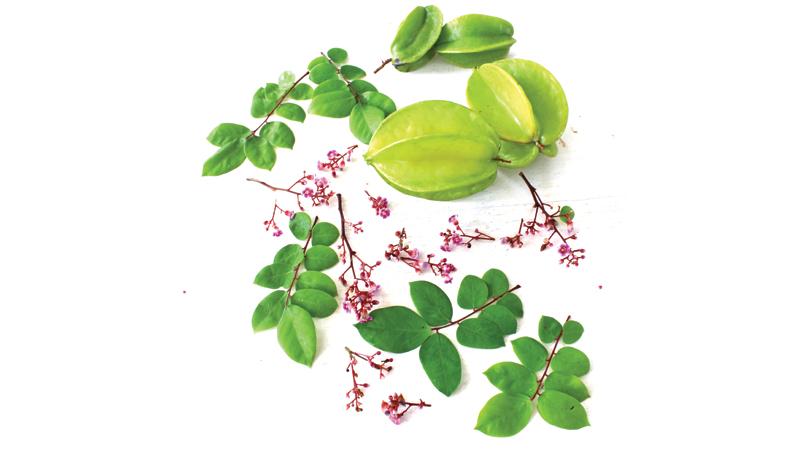
Named after its shape, star fruit or carambola is a succulent fruit rich in vitamin C, A and many other micronutrients.
Known scientifically as ‘Averrhoacarambola’, star fruit belongs to the Oxalidaceae family. The tree grows up to 5-12metres in height and bears tiny flowers which are beautiful and purple (pink) in colour.
The raw green fruit is transformed to bright yellow colour which tastes sweet with a tinge of sourness when ripened. There are two types of carambola trees which bear fruit in two sizes. Large sized fruits taste sweeter and the small sized variety is sour (due to its high oxalic acid content) even after the fruit is ripened. Some star fruits still retain their green colour after they are ripened and taste sweet.
Carambola is said to have originated in Southeast Asian tropical countries such as Malaysia and Indonesia. Although grown in Sri Lanka, the fruit is not very popular among the public in comparison to other common fruits. This is also not a commonly available fruit in markets and food fairs.
The tree is well grown in the intermediate zone in Sri Lanka with warm and humid weather. Star fruit is propagated through seeds and the fruits can be yielded after two years of planting seeds.
The harvest is comparatively less in the first year and gradually increases when the tree grows old. The yield can be obtained from a well grown Carambola tree for over 25 years and average annual harvest is about 100 kg per tree.
Ethno-medicinal uses
 Carambola is a sour fruit. Hence it contains a large amount of vitamin C which aids in relieving the common cold. In Sri Lankan ethno-medicine, mashed Kamaranka (carambola / star fruit) is applied on wounds caused by corroded sharp iron objects such as iron nails and barbed wire.
Carambola is a sour fruit. Hence it contains a large amount of vitamin C which aids in relieving the common cold. In Sri Lankan ethno-medicine, mashed Kamaranka (carambola / star fruit) is applied on wounds caused by corroded sharp iron objects such as iron nails and barbed wire.
Ayurvedic texts state that star fruit is aphrodisiac. Local medical practitioner Dr. Palitha Sri Geegana Arachchige says that star fruit enhances the immunity in the body.
“Kamaranka is one of the fruits that we can incorporate into our diets during this pandemic period to enhance immunity in the body to fight the virus,” he says.
“Star fruit helps strengthen bones and helps proper function of the nervous system. It also helps improve memory,” says the doctor.
Star fruit is recommended for diabetes patients by the Ayurvedic doctors due to its ability to regulate blood sugar level. “Star fruit is also given for those with reproductive issues.
In Sri Lankan ethno-medicine, star fruit is given for men with infertility,” says Dr. Arachchige.
Although star fruit has many health benefits, the fruit can be lethal for some people with certain diseases. “Star fruit should not be consumed by people with renal diseases. The fruit contains oxalate which is toxic for patients with kidney diseases as well as those suffering from bladder stones,” he says.
Dishes made of carambola
The outer ridges as well as the white stripes found inside the fruit (where seeds are located) should be removed when consuming star fruit as such parts contain toxins. In Sri Lanka, star fruit is mainly consumed as a fruit as well in the form of juice. In some parts of Sri Lanka raw star fruit is used as a vegetable to prepare curry. Curried carambola is delicious and can be served with rice.
Other than curry, jam, chutney, cocktails and many desserts can be prepared using this less popular fruit.
Jam
Star fruit jam can be prepared when the fruits are abundantly grown in trees. To prepare star fruit jam, clean the fruits and remove the outer and inner ridges. Remove the seeds too. Mash or grind the star fruit. Heat a clay pot, add mashed star fruit (about 450g) and four cups of sugar. Stir using a coconut shell ladle until the sugar is dissolved. Under high heat, boil the mixture. Transfer to sterile jars and process in a water bath. Refrigerate.
Chutney
Clean the fruits and remove the inner and outer ridges. Dice the fruits. Heat a clay pot and add sesame oil. Add mustard seeds. When the mustard seeds start spluttering, add diced star fruit. After a couple of minutes add kitul jaggery. Let the jaggery dissolve. Add a little chili powder and salt. Cook until the star fruits are softened.
Curried star fruit
Repeat the same process as above to prepare star fruit for consumption. In a clay pot add chopped onion, green chili, curry leaves, pandan leaf, a small cinnamon stick, garlic, curry powder, chili powder, turmeric powder and diced star fruit. Then add second extract coconut milk, mix well and cook until the star fruit is softened.
Then add a small piece of kitul jaggery to expel the pungently sour flavour of Kamaranka. First add extracted coconut milk and salt. Stir well and boil for another five minutes.
Juice
Clean the fruit and remove the outer and inner ridges along with seeds. Blend with sugar and a few ice cubes. Strain the fruit pulp and consume.
Fruit granita
In a container, combine star fruit juice and sugar. Freeze this for an hour. Then take it out from the refrigerator and break the ice with a fork. Repeat this at least five times until you get ice crystals. Top the star fruit granita with sweet yoghurt and enjoy on a warm afternoon.
Daiquiri
In a cocktail shaker, combine two ounces of light rum, two ounces of star fruit juice, ice cubes and three-fourth ounce sugar syrup. Shake well. Then strain into a chilled cocktail glass. Garnish with a star fruit slice.

